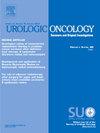阴茎控制CO2激光切除阴茎鳞状细胞癌的器官保存和肿瘤疗效:早期和晚期结果在一个高容量中心。
IF 2.4
3区 医学
Q3 ONCOLOGY
Urologic Oncology-seminars and Original Investigations
Pub Date : 2025-05-01
DOI:10.1016/j.urolonc.2025.02.024
引用次数: 0
摘要
目的:评价CO2激光保守治疗阴茎非溃疡性鳞状细胞癌(SCC)的安全性及早期和长期疗效。材料和方法:在我们的机构数据库(包括2002-2022年)中,我们确定了122例连续接受保守CO2激光治疗的cT1-2 cN0 cM0阴茎SCC患者。组织学证实有局部复发记录。局部复发在第一次激光治疗后2年被归类为早期复发。采用单变量和多变量Cox回归模型(MCRMs)分析疾病复发的预测因素。结果:中位随访时间为36个月[四分位间距(IQR) 21-73个月]。中位年龄62岁(IQR: 51-69岁)。中位最大病变大小为10 mm (IQR 5-15 mm)。阴茎上皮内瘤变(PeIN) 62例(51.6%),pT1 m 30例(24.6%),pT1 28例(23%),pT2 1例(0.8%),pTx 2例。侵袭性病变中,G1 37例(60.7%),G2 20例(32.8%),G3 4例(6.5%)。早期和晚期复发分别为28例(22%)和21例(18%)。2年和5年阴茎保存率分别为93.4%和92.6%。pT1期[危险比(HR) 13,可信区间(CI) 1.4-73, p值0.02]和扁平病变(HR 7.9, CI 1.06- 59,0.04)是晚期复发的独立预测因子。中位随访36个月后,无癌症相关死亡记录。结论:据我们所知,这是接受保守CO2激光治疗的阴茎cT1-T2 SCC患者中最大的队列。这些患者中绝大多数(92%)在5年内保留了他们的器官。有些因素可用于预防或预测晚期复发。本文章由计算机程序翻译,如有差异,请以英文原文为准。
Organ preservation and oncological efficacy of peniscopically controlled CO2 laser excision of penile squamous cell carcinoma: Early and late results in a high-volume center
Objectives
To evaluate safety and early and long-term efficacy of CO2 laser conservative treatments for nonulcerative squamous cell carcinoma (SCC) of the penis.
Material and Methods
Within our institutional database (2002–2022, included), we identified 122 consecutive cT1-2 cN0 cM0 patients with penile SCC who underwent conservative CO2 laser treatments. Histologically confirmed local relapses were recorded. Local relapses were classified as early recurrences when occurring <2 years and as late new tumor recurrences when occurring >2 years after first laser treatment. Predictors of disease relapse were analyzed with univariable and multivariable Cox regression models (MCRMs).
Results
Median follow-up was 36 months [Interquartile range (IQR) 21-73 months]. Median age was 62 years (IQR: 51-69 years). Median largest lesion size was 10 mm (IQR 5-15 mm). 62 patients had penile intraepithelial neoplasia (PeIN) (51.6%), 30 had pT1 m (24.6%), 28 had pT1 (23%) and 1 had pT2 (0.8%), 2 patients were classified as pTx. In case of invasive lesions, tumor Grade was G1 in 37 (60.7%), G2 in 20 (32.8%), G3 in 4 (6.5%). Early and late recurrences occurred in 28 (22%) and in 21 patients (18%), respectively. Proportion of penis preservation was 93.4% and 92.6% at 2 and 5 years. pT1 stage [Hazard Ratio (HR) 13, Confidence Interval (CI) 1.4-73, p-value 0.02] and flat lesions (HR 7.9, CI 1.06-59, 0.04) achieved independent predictor status for late recurrences. No cancer related deaths were recorded after a median follow-up of 36 months.
Conclusions
As far as we know, this is the largest cohort of patients with penile cT1-T2 SCC who underwent conservative CO2 laser treatment. The vast majority (92%) of these patients preserved their organ at 5 years. Some factors can be of use in preventing or anticipating late recurrences.
求助全文
通过发布文献求助,成功后即可免费获取论文全文。
去求助
来源期刊
CiteScore
4.80
自引率
3.70%
发文量
297
审稿时长
7.6 weeks
期刊介绍:
Urologic Oncology: Seminars and Original Investigations is the official journal of the Society of Urologic Oncology. The journal publishes practical, timely, and relevant clinical and basic science research articles which address any aspect of urologic oncology. Each issue comprises original research, news and topics, survey articles providing short commentaries on other important articles in the urologic oncology literature, and reviews including an in-depth Seminar examining a specific clinical dilemma. The journal periodically publishes supplement issues devoted to areas of current interest to the urologic oncology community. Articles published are of interest to researchers and the clinicians involved in the practice of urologic oncology including urologists, oncologists, and radiologists.

 求助内容:
求助内容: 应助结果提醒方式:
应助结果提醒方式:


